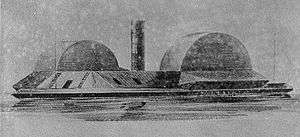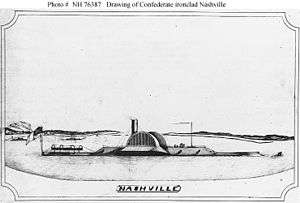CSS Nashville (1864)
 | |
| History | |
|---|---|
| Laid down: | September 1862 |
| Launched: | mid-1863 |
| Commissioned: | 15 September 1864 |
| Decommissioned: | 10 May 1865 |
| Fate: | Surrendered to U.S. forces; sold 22 November 1867 |
| General characteristics | |
| Displacement: | approximately 1100 tons |
| Length: | 271 ft (82.6 m) |
| Beam: | 62 ft 6 in (19.1 m) |
| Draft: | 10 ft 9 in (3.3 m) |
| Propulsion: | 2 steam engines |
| Speed: | unknown |
| Complement: | unknown |
| Armament: |
|
CSS Nashville was a large side-wheel steam casemate ironclad built by the Confederates late in the American Civil War.
Description
The ship was 271 feet (82.6 m) long overall, had a beam of 62 feet 6 inches (19.1 m) and a draft of 10 feet 9 inches (3.3 m). The side wheels were powered by two steam engines with a 9-inch (229 mm) bore and a 36-inch (914 mm) stroke. She was armed with three 7-inch (178 mm) Brooke rifles and a 24-pounder howitzer.[1]
Construction and career
Nashville was laid down at Montgomery, Alabama because of the availability of riverboat engines there. Launched in mid-1863, Nashville was taken to Mobile, Alabama for completion in 1864. Part of her armor came from the CSS Baltic. Her first commander was Lieutenant Charles Carroll Simms, CSN.
Still fitting out, she took no part in the Battle of Mobile Bay on 5 August 1864. She helped fend off attacks on Spanish Fort, Alabama on 27 March 1865, supported Confederate commander Randall L. Gibson until driven away by Federal batteries, and shelled Federal troops near Fort Blakely on 2 April 1865. The ships retreated up the Tombigbee River 10 days later when Mobile surrendered. She was one of the vessels formally surrendered by Commodore Ebenezer Farrand, CSN, at Nanna Hubba, Alabama on 10 May 1865.
Although never quite finished, she had been heavily armored with triple 2-inch plating forward and around her pilot house, only a single thickness aft and there had been some doubts expressed that her builders might have overestimated her structural strength. Rear Admiral Henry K. Thatcher, USN, wrote on June 30, 1865, after survey, "She was hogged when surrendered and is not strong enough to bear the weight of her full armor." He was certain "she could not live in a seaway."
Following her surrender, Nashville was laid up until 22 November 1867, when she was sold for scrap at New Orleans, Louisiana, her armor having previously been stripped for reuse in other vessels.
Commanders
- Lieutenant Charles Carroll Simms (1864)
- Lieutenant John W. Bennett (late 1864 - May 1865)
-

Rebel Ram CSS Nashville
-

Sketch Ram CSS Nashville
Notes
- ↑ Silverstone, pp. 154–55
References
- Silverstone, Paul H. (2006). Civil War Navies 1855–1883. The U.S. Navy Warship Series. New York: Routledge. ISBN 0-415-97870-X.
- Still, William N., Jr. (1985). Iron Afloat: The Story of the Confederate Armorclads (Reprint of the 1971 ed.). Columbia, South Carolina: University of South Carolina Press. ISBN 0-87249-454-3.
This article incorporates text from the public domain Dictionary of American Naval Fighting Ships. The entry can be found here.